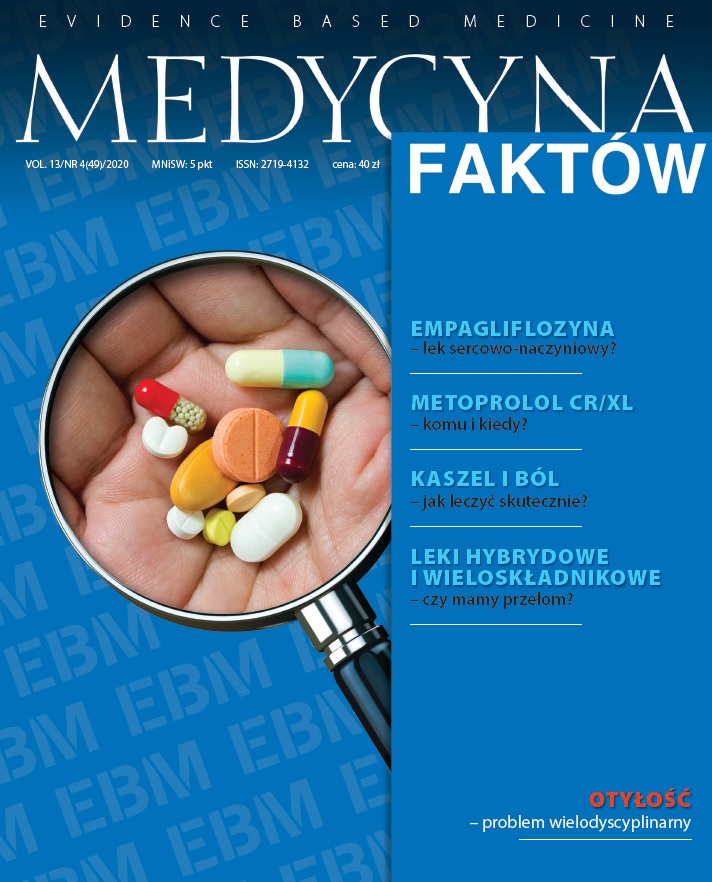Zastosowanie pantoprazolu i famotydyny w chorobie refluksowej przełyku Opis przypadku
##plugins.themes.bootstrap3.article.main##
Abstrakt
Choroba refluksowa przełyku to jedna z najczęstszych chorób przewodu pokarmowego. Częstość jej występowania jest porównywalna u mężczyzn, jak i u kobiet oraz wzrasta wraz z wiekiem (nasila się po 40. r.ż.). Istotą choroby jest cofanie się kwaśnej treści żołądkowej do światła przełyku i powodowanie miejscowego podrażnienia błony śluzowej. Głównym objawem choroby refluksowej przełyku jest zgaga, czyli uczucie pieczenia za mostkiem, nasilająca się często po obfitym i tłustym posiłku lub zmianie pozycji ciała (po pochyleniu, na leżąco). Objawy, w tym również pozaprzełykowe, mogą występować także w nocy (nawet u 45–80% pacjentów z chorobą refluksową przełyku) i nie zawsze od razu są kojarzone z refluksem. Podstawę leczenia stanowią leki hamujące wydzielanie kwasu solnego. Celem artykułu jest omówienie na podstawie przypadku pacjenta korzystnego połączenia pantoprazolu z famotydyną w celu opanowania objawów oraz poprawy jakości życia.
##plugins.themes.bootstrap3.article.details##
Copyright © by Medical Education. All rights reserved.
Bibliografia
2. Vakil N, van Zanten SV, Kahrilas P et al. The Montreal definition and classification of gastroesophageal reflux disease: a global evidence-based consensus. Am J Gastroenterol. 2006; 101: 1900-20.
3. Lundell L, Dent J, Bennett J et al. Endoscopic assessment of oesophagitis: clinical and functional correlates and further validation of the Los Angeles classification. Gut. 1999; 45: 172-80.
4. Jones RH, Hungrin ADS, Philips J. Gastroesophageal reflux disease in primary care in Europe: clinical presentation and endoscopic findings. Eur J Gen Pract. 1995; 1: 149-54.
5. Bodger K, Trudgill N. Guidelines for oesophageal manometry and pH monitoring. BSG, London 2006.
6. Ness-Jensen E, Hveem K, El-Serag H et al. Lifestyle intervention in gastroesophageal reflux disease. Clin Gastroenterol Hepatol. 2016; 14: 175-82.
7. Ambrecht U, Abucar A, Hameeteman W et al. Treatment of reflux oesophagitis of moderate and severe grade with ranitidine or pantoprazole – comparison of 24-hour intragastric and oesophageal pH. Aliment Pharmacol Ther. 1997; 11(5): 959-65.
8. Wedemeyer R-S, Blume H. Pharmacokinetic drug interaction profiles of proton pump inhibitors: an update. Drug Saf. 2014; 37: 201-11.
9. Shi S, Klotz U. Proton pump inhibitors: an update of their clinical use and pharmacokinetics. Eur J Clin Pharmacol. 2008; 64: 935-51.
10. Gerson LB, Triadafilopoulos G. Proton pump inhibitors and their drug interactions: an evidence-based approach. Eur J Gastroenterol Hepatol. 2001; 13: 611-6.
11. Dąbrowski A, Štabuc B, Lazebnik L. Meta-analysis of the efficacy and safety of pantoprazole in the treatment and symptom relief of patients with gastroesophageal reflux disease – PAN-STAR. Prz Gastroenterol. 2018; 13(1): 6-15.
12. Mainie I, Tutuian R, Castell DO. Addition of a H2 receptor antagonist to PPI improves acid control and decreases nocturnal acid breakthrough. J Clin Gastroenterol. 2008; 42(6): 676-9.
13. Echizen H, Ishizaki T. Clinical pharmacokinetics of famotidine. Clin Pharmacokinet. 1991; 21(3): 178-94.
14. Rackoff A, Agrawal A, Hila I et al. Histamine-2 receptor antagonists at night improve gastroesophageal reflux disease symptoms for patients on proton pump inhibitor therapy. Dis Esophagus. 2005; 18: 370-3.
15. Tutuian R, Castell DO. Nocturnal acid breakthrough – approach to management. MedGenMed. 2004; 6(4): 11.
